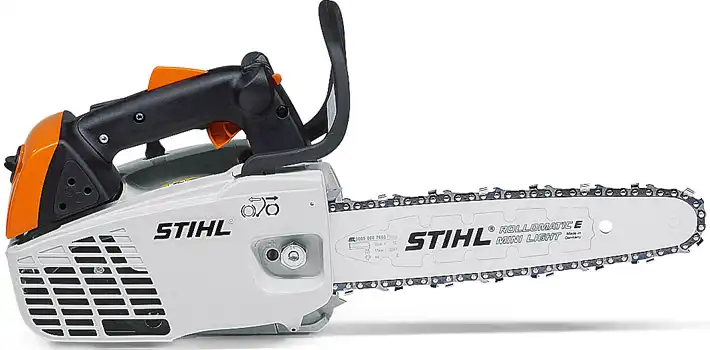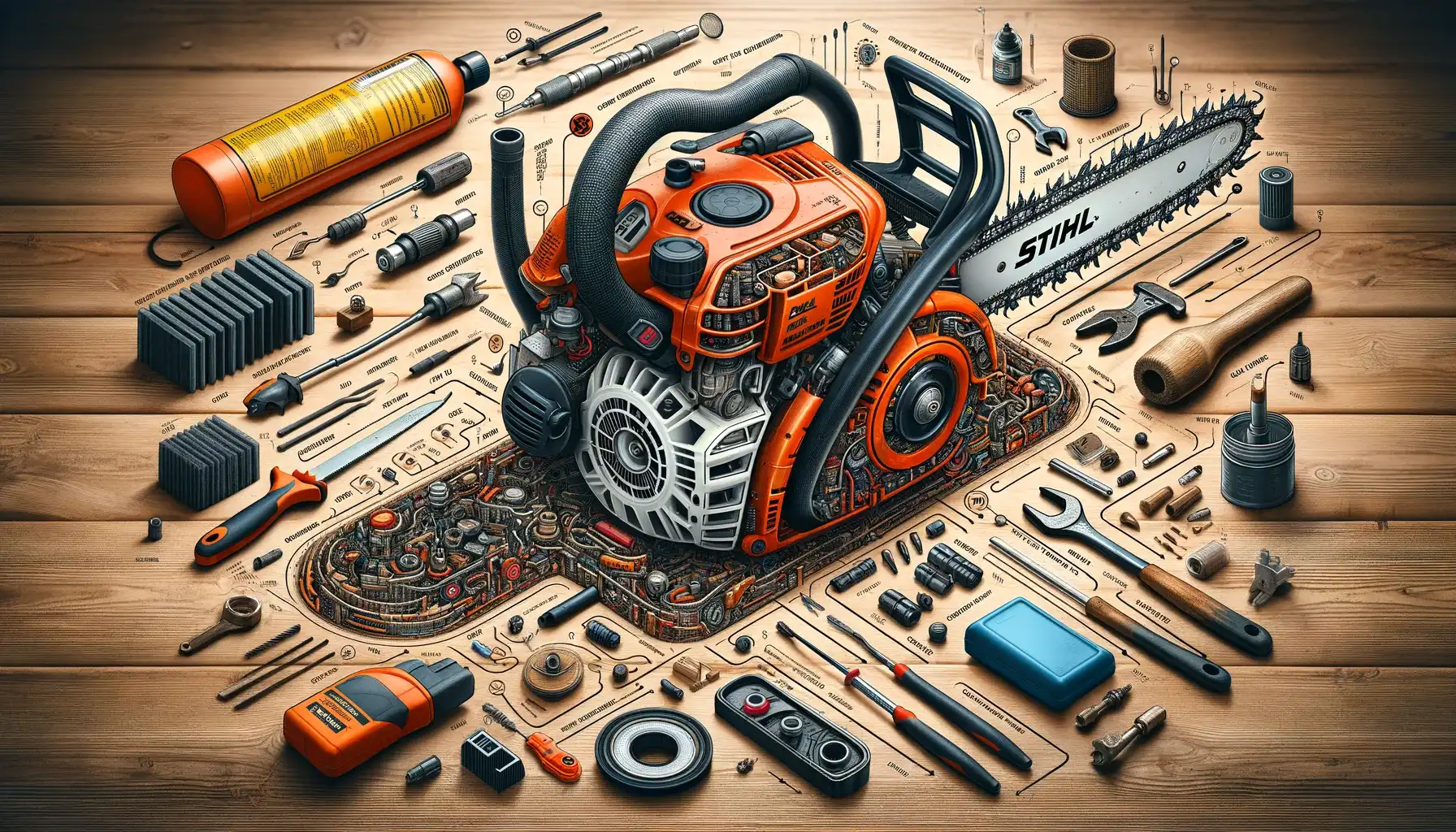Common problems with the Stihl MS 192 T chainsaw include starting difficulties, idling issues, and power loss. The Stihl MS 192 T is a lightweight chainsaw favored by arborists for its maneuverability and ease of use.
Despite its popularity, users may encounter challenges such as a clogged air filter, a malfunctioning carburetor, or a dull chain, all of which can impact performance and safety. Routine maintenance is crucial to prevent these common issues and ensure the chainsaw operates efficiently.
By addressing these problems promptly, users can extend the life of their Stihl MS 192 T and maintain optimal cutting effectiveness for both professional and personal forestry tasks.

The Stihl Ms 192 T Chainsaw
The Stihl MS 192 T chainsaw. Known for its lightweight design, this chainsaw is a top choice for professionals. Users count on its reliability and performance during tedious tree trimming tasks. Let’s dive deep into what makes the MS 192 T stand out and how it may also face challenges during operation.
Overview of the Stihl MS 192 T Model
The Stihl MS 192 T is a compact powerhouse, specifically made for arboricultural work. It features a 2-MIX engine, promising reduced emissions and lower fuel consumption. Its power-to-weight ratio ensures balance and comfort for the user.
Significance of Reliability in Chainsaws
Reliability in chainsaws ensures tasks are done smoothly and safely. A reliable chainsaw keeps productivity high and maintenance low. This is crucial for professionals who depend on their tools daily.
Common Usage Scenarios For the Stihl Ms 192 T
- Tree pruning – Perfect for cutting branches without hassle.
- Crown reduction – It makes shaping tree canopies easy.
- Deadwood removal – Safely removes dead branches.
Starting Issues With the Stihl Ms 192 T
The Stihl MS 192 T chainsaw is a trusted tool. Occasional starting issues can keep you from your tasks. This section sheds light on common starting problems and ways to fix them.
Troubleshooting the Ignition System
Is your chainsaw not sparking to life? The ignition system could be at fault. Here’s a quick checklist for troubleshooting:
- Check the spark plug for carbon buildup or damage.
- Inspect wires and connections for faults.
- Test the ignition coil with a multimeter.
Replace parts if they show signs of wear.
Role of Maintenance in Starting Reliability
Maintenance can make or break your chainsaw’s reliability. Here are maintenance tips:
- Keep the air filter clean for proper engine breathing.
- Ensure fuel mix is correct and fresh.
- Clean the carburetor to prevent blockages.
Follow these to keep your saw ready to start.
User Experiences and Solutions With Starting Problems
Users often share how they tackle starting issues. Below are common experiences:
| Solution | User Experience |
|---|---|
| Check fuel lines | “Replaced a cracked fuel line and it started right up!” |
| Adjust carburetor | “A slight tweak to the carb and my Stihl sprang to life.” |
| Clean the spark arrestor | “The arrestor was clogged. Cleaned it and the issue was fixed.” |
Try these solutions to fix your starting woes.
Engine Performance and Operation Hiccups
Many Stihl MS 192 T users face challenges with engine performance. These hiccups can stem from various issues. Properly diagnosing and addressing these problems is key to keeping your chainsaw running smoothly.
Identifying Carburetor-related Complications
Carburetor issues manifest as irregular idling, difficulty starting, or unexpected stalls. Look for these signs:
- Difficulty starting: The engine doesn’t turn on easily.
- Erratic idling: The engine revs up or down by itself.
- Stalling: The engine stops running during operation.
Resolve these by cleaning the carburetor and checking the adjustment screws. Professional tuning might be necessary if the problem persists.
Impact of Fuel Quality on Engine Performance
High-quality fuel is crucial for optimum engine performance. Poor fuel can cause:
- Power Loss: The engine may lose power and perform weakly.
- Gummy Deposits: Bad fuel leaves residues, clogging the system.
- Hard Starting: It becomes difficult to start the chainsaw.
Use fresh, clean fuel and a proper oil mix to prevent these issues. Replace the fuel if it’s been sitting in the tank for over a month.
Adapting to Altitude and Temperature Changes
Changes in altitude and temperature affect engine performance. Higher altitudes can cause:
- Thinner air: The engine gets less oxygen, affecting combustion.
- Cooler temperatures: Cold can thicken oil, making it hard for the engine to run.
Adjust the carburetor settings to compensate for these changes. Refer to the manual for precise adjustments. This ensures reliable operation across different conditions.
Bar and Chain Dilemmas
The Stihl Ms 192 T chainsaw relies heavily on its bar and chain to perform cutting tasks efficiently. When they run into problems, it can halt your work. Let’s explore common bar and chain dilemmas and learn how to tackle them.
Common Issues With the Guide Bar Alignment
Proper alignment of your chainsaw’s guide bar is crucial for accurate cutting. Misalignment can lead to several issues:
- Uneven cuts: The saw might cut at an angle rather than straight through the wood.
- Excessive wear: Parts of the bar wear down unevenly, leading to a shorter lifespan.
- Difficulty controlling the saw: A misaligned bar can make the tool harder to handle.
To check alignment:
- Turn off the saw.
- Loosen the nuts that clamp the bar to the saw.
- Adjust the bar so that it’s perfectly straight.
- Tighten the nuts back without shifting the bar.
Chain Tension and Lubrication Problems
Proper tension and lubrication keep the chain running smoothly. Symptoms of issues include:
- Slack chain: Causes the chain to sag away from the bar and can lead to it coming off.
- Too tight: Stretches the chain and causes excessive wear.
- Poor lubrication: Results in increased friction, heat, and damage.
Maintenance steps to follow:
- Check chain tension before each use.
- Adjust the tensioning screw until the chain fits snugly against the bar.
- Fill the oil reservoir to ensure proper lubrication.
- Check for smooth chain movement and good oil flow on the bar.
Wear and Replacement Guidelines for the Bar and Chain
Regular use of your chainsaw leads to wear and tear of the bar and chain. Recognizing when to replace them is key:
| Component | Signs of Wear | Action |
|---|---|---|
| Guide Bar | Dents, bends, or visible wear patterns | Replace the guide bar |
| Chain | Dull teeth, broken links, or cannot be tensioned | Replace the chain |
Follow these guidelines:
- Inspect the bar and chain after each use.
- Look for any signs of wear that could compromise safety or efficiency.
- Refer to the Stihl Ms 192 T manual for specific replacement instructions.
- Always use Stihl-approved bars and chains for replacements to maintain optimal performance.
Handling and Ergonomic Concerns
When tackling tough jobs, the Stihl MS 192 T chainsaw should handle with ease. Yet, users have voiced concerns related to handling and ergonomics. For professional arborists or home users, the comfort and balance of the chainsaw are critical for both safety and efficiency. Below, we delve into the key issues and enhancements that address these concerns.
Design Issues Affecting Chainsaw Balance and Grip
The Stihl MS 192 T is designed for arborists who demand precision and control in their equipment. Despite this, design flaws can impact balance and make handling tricky. The arrangement of the engine and handle can lead to uneven weight distribution, which in turn affects grip and maneuverability.
Vibration Levels and User Fatigue
Long periods of chainsaw use can lead to fatigue, affecting both productivity and safety. The MS 192 T chainsaw sometimes exhibits higher vibration levels, which can accelerate user fatigue. Understanding how vibration contributes to fatigue can help users plan their work more effectively and take necessary breaks.
Ergonomic Enhancements and Personal Protective Equipment
Stihl recognizes these ergonomic challenges and has implemented solutions. Enhancements like the anti-vibration system and improved handle design aim to reduce strain on the user. Pairing these advancements with the correct personal protective equipment, such as gloves and anti-vibration pads, can significantly enhance the overall user experience and safety.
- Anti-Vibration System: Reduces the amount of vibration transferred to the user, minimizing fatigue.
- Adjustable Handles: Allow for better grip and control, tailoring the fit to the individual.
- PPE Gear: Essential for protection and comfort, including gloves, helmets, and ear protection.
Service, Maintenance, and Longevity
Maintaining your Stihl MS 192 T chainsaw is the key to its longevity and efficiency. Proper service and upkeep prevent common problems and extend the life of your equipment. This guide highlights the essential maintenance routines, parts support, and care tips for this chainsaw model.
Routine Maintenance Schedule For the Ms 192 T
- Check the air filter monthly.
- Sharpen the chain every time you refuel.
- Clean the spark arrester screen every 10 hours of usage.
- Inspect the fuel line and replace it if it’s cracked or old.
- Check the tension of the chain before each use.
Dealing With Parts Availability and Aftermarket Support
Finding the right parts ensures your Stihl MS 192 T runs smoothly. Sometimes, original parts may be hard to find.
| Availability | Sources |
|---|---|
| OEM Parts | Licensed dealers |
| Aftermarket Parts | Reputable third-party sellers |
Always use trusted suppliers for replacements to ensure compatibility and safety.
Extending the Lifespan of the Stihl MS 192 T Through Care
Regular cleaning and proper storage are crucial for extending its lifespan. Here are the best practices:
- Store the chainsaw in a dry, clean place.
- Empty the fuel tank if stored for long periods.
- Lubricate the chain regularly to prevent wear.
Attention to detail and consistent maintenance reward you with a durable and reliable Stihl MS 192 T chainsaw.
Learn more: Husqvarna 460 Rancher Problems and Maintenance Tips
FAQs on Stihl Ms 192 T Problems
What Are Common Reasons Stihl Chainsaw Won’t Start?
Common reasons a Stihl chainsaw won’t start include a fouled spark plug, stale fuel, a clogged carburetor, faulty ignition, or a dirty air filter. Ensure regular maintenance for optimal performance.
Why Does My Stihl Chainsaw Loses Power?
Your Stihl chainsaw may lose power due to a dirty air filter, stale fuel, a clogged carburetor, or a dull chain. Regular maintenance and timely replacements can restore performance.
What to Do if Stihl Chainsaw Is Flooded?
To fix a flooded Stihl chainsaw, remove the spark plug, dry it off, and drain excess fuel from the chamber. Next, pull the starter several times to ventilate the engine. Reinstall the plug, set the choke to “off,” and attempt to start the saw again.
How Many CC Is a Stihl 192?
The Stihl 192 chainsaw features a 30. 1cc engine.
Conclusion
Troubleshooting your Stihl MS 192 T can feel daunting, but with the right guidance, it’s manageable. Regular maintenance and understanding common hiccups will enhance your saw’s longevity and performance. Remember, staying informed and proactive is key to keeping your chainsaw in top shape for any task ahead. Chainsaw Hive is buzzing with the latest chainsaw insights in our Knowledge space. Join the hive and stay in the loop!
